| Back to Back Issues Page |
 |
|
Bangkok Travelbug January 14 Sri Satchanalai Historical Park, Sukhothai December 29, 2013 |
| Hello
Brief history of Sukhothai Sukhothai is an old kingdom founded by King Sri Indraditya (Pho Khun Sri Indraditiya) in the early 13th C who ruled from 1239 – 1257. After his death his second son became ruler until 1277 when another son Ramkhamhaeng became king. King Ramkhamhaeng’s (1277 – 1298) reign is remembered in history for its peace and prosperity for the people. The famous saying in Thai, "There are fish in the rivers and rice in the fields", reflects the golden age of that period. From a small region covering Sukhothai, Sawan Khalok, Uttaradit, Kamphaeng Phet and Tak, King Ramkhamhaeng gradually increased his influence way beyond this region. By a combination of military force and diplomacy his kingdom, at the height his reign, extended to Phisanulok to the north, Vientiane to the east, Pagan to the west and Nakhon Si Thammarat to the south. After his death in 1298, the kingdom disintegrated and was absorbed into a new centre of power that emerged with the founding of Ayutthaya in 1351. The historic towns of Sukhothai suffered the same fate with the destruction Ayutthaya by the Burmese in 1569 and again in 1767. For more on Ayutthaya, please see Ayutthaya – from the ashes of destruction. Table of contents Sukhothai UNESCO World Heritage cities In 1991, the historic town of Sukhothai and Associated Historic Towns of Si Satchanalai and Kamphaeng Phet were inscribed in the UNESCO World Heritage list. These three old towns were the principal centres of the kingdom of King Ramkhamhaeng.
Table of contents Si Satchanalai city There is evidence of life around Si Satchanalai that dates back to the 1st C long before Buddhism was introduced in the area. Later in the 6th - 9th C, Dvaravati, a Buddhist civilization developed in the region of central and north-eastern Thailand. In the 13th C Si Satchanalai became an important city in the Sukhothai kingdom. The old city is about 550 km north of Bangkok and the historical park just outside the city covers 45.14 sq km. This area is not just the area within the walls of the old city but all the monuments and ancient kilns in the surrounding area. There are 287 sites of old ruins within this historical park which was officially opened by HRH Crown Princess Sirindhorn in November 1990 a year before it was inscribed as a UNESCO World Heritage site. The monuments of Si Satchanalai are an important source of Thai history and the architecture and art of this period had a significant influence on the subsequent Ayutthaya and the Rattanakosin eras. Table of contents Layout and tour of the historical park The old walls around the historical park appear low as they have been covered by centuries of sediment. It was only by excavation that parts of the old wall and the monuments have been uncovered. Here are some of the more significant ruins in the Si Satchanalai Historical Park. We toured the main historical park on foot and these are the places we covered. Please see map of the locations of this ruins in the historical park. View Layout of Si Satchanalai Historical Park in a larger map Wat Suan Kaeo Utthayan Noi Wat Suan Kaeo Utthayan Noi was our first stop. There are signboards near each monument to show how it would look in its original form. 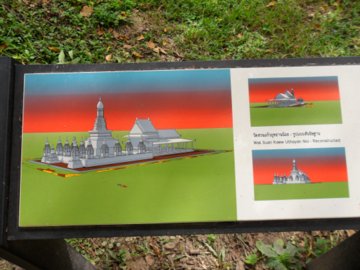
Artist’s reconstruction 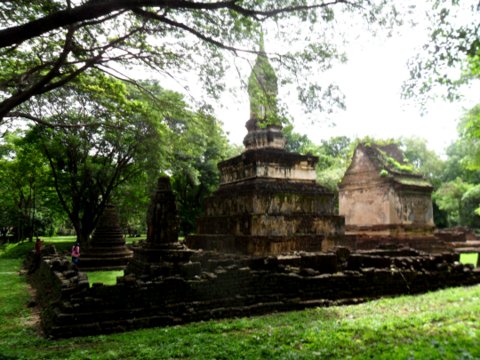
The ruins 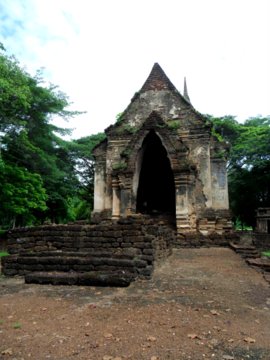
Remains of the building to the rear 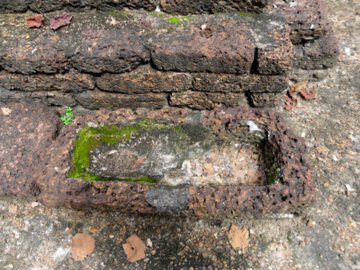
Close-up of the old stones Wat Khao Phanom Phloeng Wat Khao Phanom Phloeng is located on a hill near the centre of the old city and overlooks the entire city. The way to this temple was tough up this flight of steep stone steps. 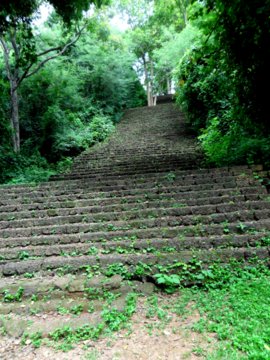
The way up At the top we found a huge Buddha image, an old chedi and shrine. The stones show heavy pitting. 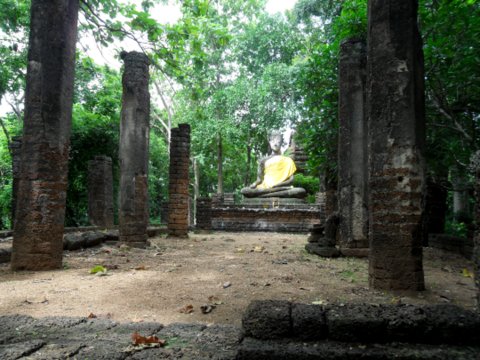
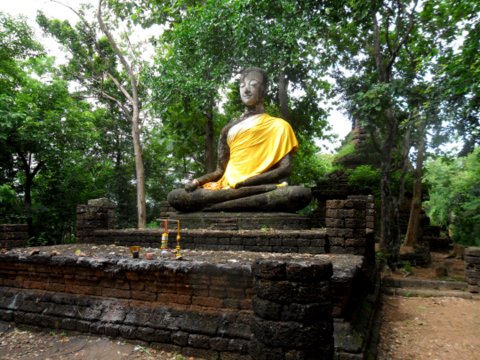
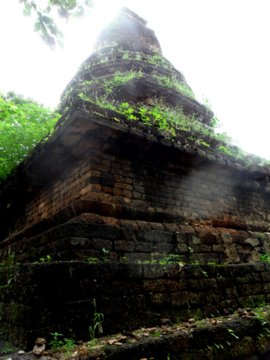
Old chedi This structure on a raised square pedestal and a pyramidal roof is called a "mondop". The locals call it "sarn chao mae le ong sam li", a shrine to the Goddess Le Ong Sam Lee. 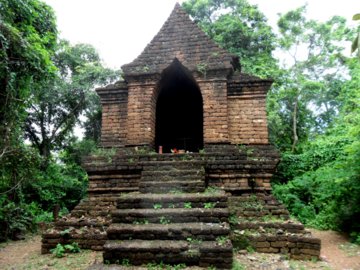
Mondop Wat Chang Lom Wat Chang Lom (surrounded by elephants) a 14th C temple is located in the centre of the old city in an open field just south of Wat Khao Phanom Phloeng. 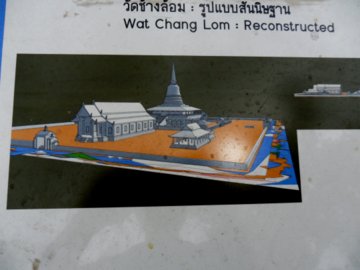
Artist’s impression The main attraction of this temple is the chedi of Sri Langka design. 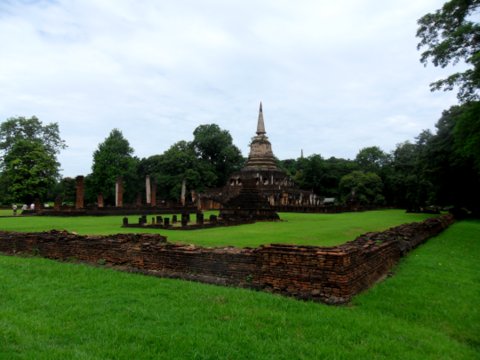
Notice the two buildings in front have been destroyed The chedi is surrounded by a low wall lined with 39 elephants. some of which are broken. 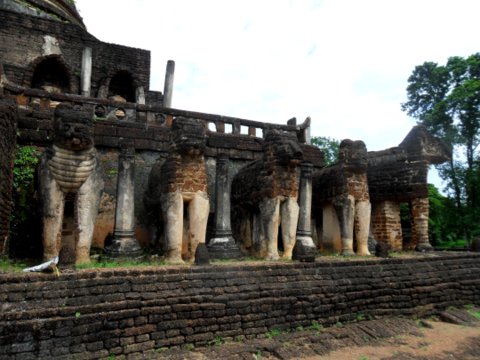
Surrounded by 39 elephants Unfortunately some of the elephants are badly damaged. 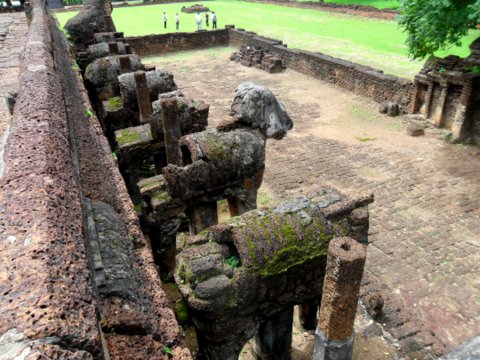
Damaged elephants Wat Chedi Ched Taeo Wat Chedi Ched Taeo (seven rows of chedi) is characterized by rows of chedi around the main chedi. 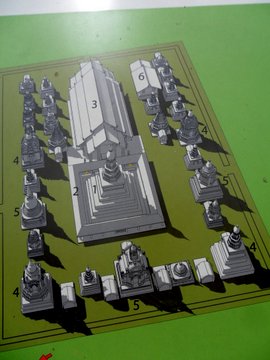
Image of the original version 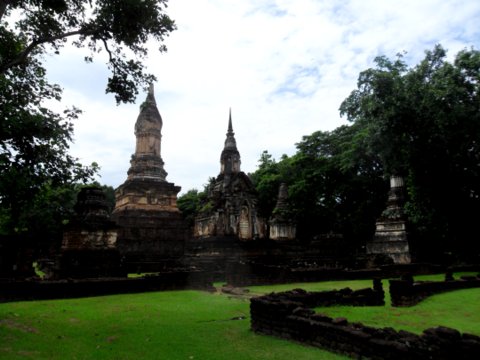
Present-day ruins In the chedi in the centre there is a sculpture of the Naga serpent providing a protective hood over Buddha. 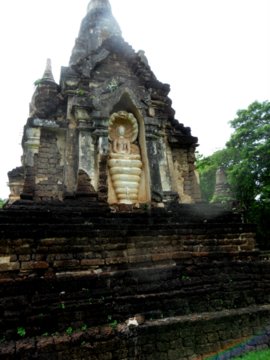
Buddha and the Naga serpent Not much is left of the building to rear except for the base and some pillars. 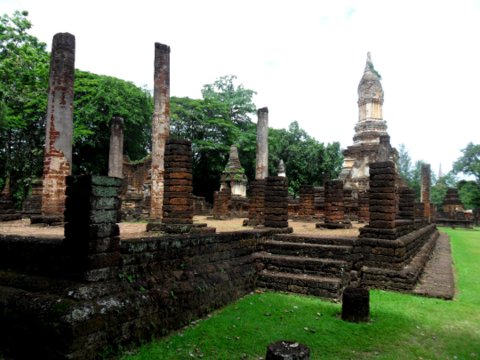
View from the rear Wat Suan Kaeo Utthayan Yai Wat Suan Kaeo Utthayan Yai like the two temples before is located on the main road leading through the old walled city. It appears to have suffered the most damage as all that’s left are these pillars. 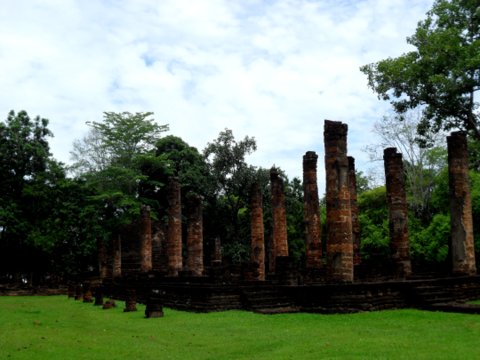
Ruins of Wat Suan Kaeo Utthayan Yai Wat Nang Phaya Wat Nang Phaya is another temple on the main road through the city and it’s located near the southern wall. The temple is a 16th C temple built in the early Ayutthaya period and faces the south-east. 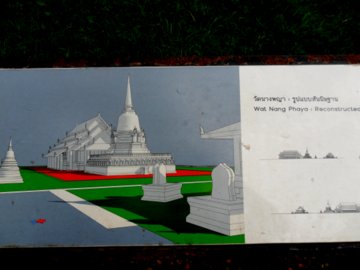
Artist’s impression of the original temple The important structure in this temple is the chedi in front which is based on the design of the chedi in Wat Phra Sri Sanphet in Autthaya . 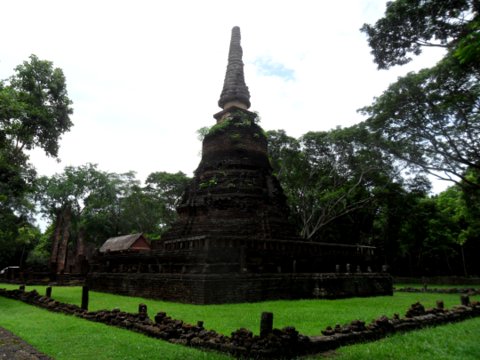
Present-day ruins The viharn to the rear is made from laterite blocks and limestone plaster. The walls have beautiful designs based on Chinese and Lanna culture. Local goldsmiths have used these patterns for gold souvenirs called "Ancient Gold of Si Satchanalai". 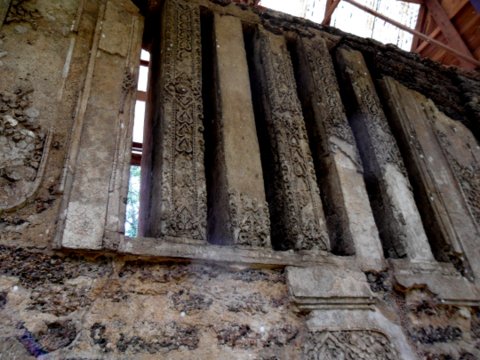
Designs on the walls of the viharn Old city walls, moat and beyond The old city of Si Satchanalai has three rings of walls on the north, west and south. To the east the old city is protected by a single wall and the Yom River. The walls which are about 2 m wide and 4 m high have 16 gates and four forts. 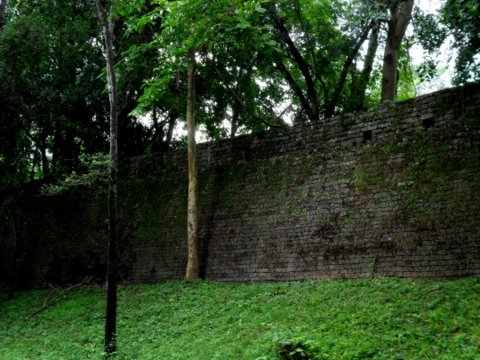
Old city walls Ramnarong Gate the largest and main gate to the city. It is defended by a moat and a fort. 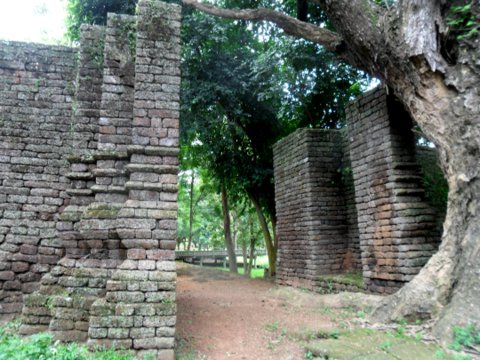
Ramnarong Gate which leads to the main road passing through the old city 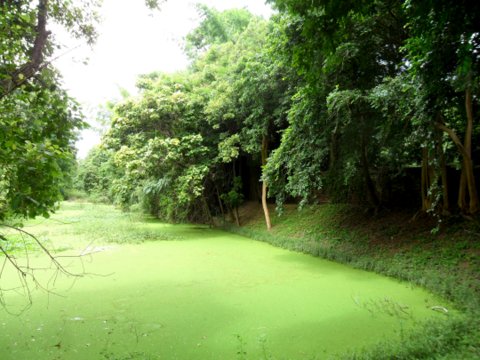
Moat outside Ramnarong Gate There two old two temples outside the city walls, Wat Thung Setthi and Wat Pa Krasa. 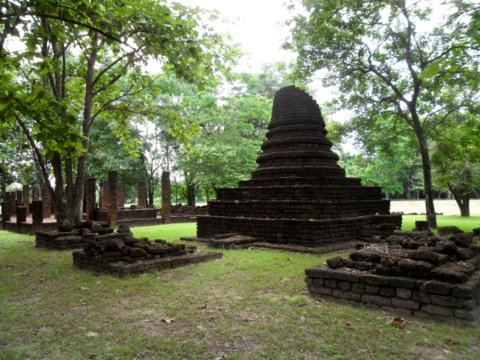
Remains of the chedi and viharn in Wat Thung Setthi 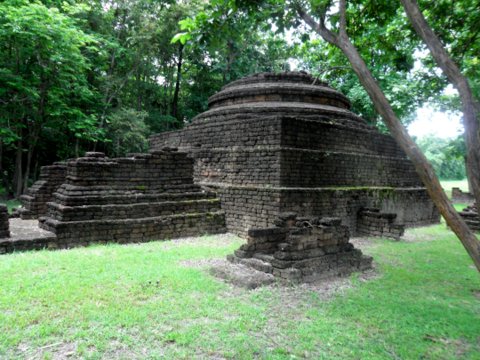
Base of the chedi in Wat Pa Krasa 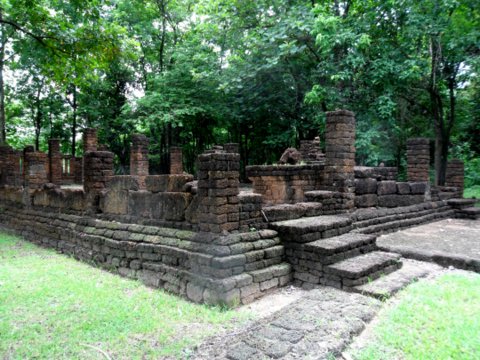
Remains of the viharn in Wat Pa Krasa Wat Sri Rattana Mahathat Rachavoraviharn Our last stop in the tour of Si Satachanalai Historical Park is Wat Sri Rattana Mahathat Rachavoraviharn a temple complex that is outside the city walls about 3 km away to the east. This temple was built in 1227. The main structure in this old temple is the prang made from laterite and surrounded by a low wall of 90x60 m. 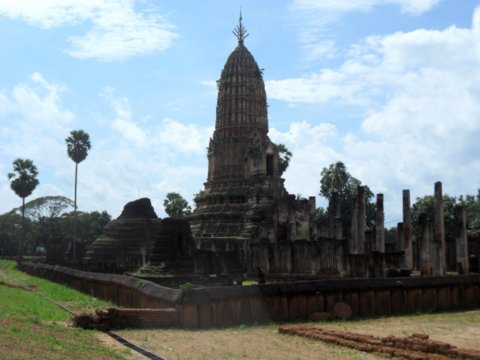
Prang The second structure is outside the walled prang. It’s called Phra That Mudao on a terraced square base on which rests a circular structure that appears to be the remains of a chedi. 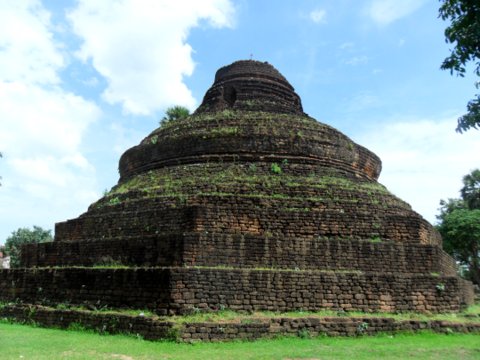
Phra That Mudao I am unable to identify this last set of ruins as we bring to an end our virtual tour of Si Satchanalai Historical Park. We hope that you have enjoyed it. 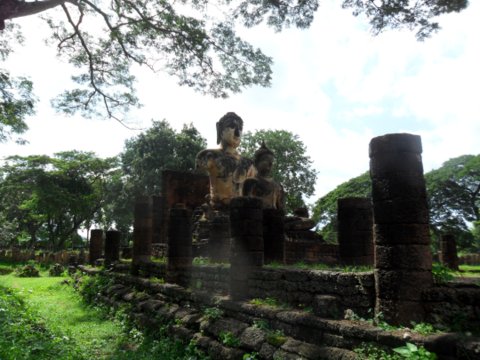
Admission fees Thais 20 baht and foreigners 100 baht Admission fee per car 50 baht Opening hours The Si Satchanalai Historical Park is open every day from 0900 – 1600 hours Table of contents Map to Si Satchanalai View Map to Si Satachanalai Historical Park in a larger map How to get to there By tour bus Take a tour bus from Mor Chit the northern bus station in Bangkok to Si Satchanalai. Do not take the bus to Sukhothai city as it terminates at the city bus terminal. The bus to Si Satchanalai bypasses Sukhothai city, passes Sawan Khalok, Si Satchanalai and ends at Phitsanulok. Fare is 409 baht to Si Satchanalai. I chose to stay in Sawan Khalok because of this beautiful hotel that came highly recommended. The fare for the return trip from Sawan Khalok to Bangkok is 387 baht. Where to stay I stayed at this beautiful hotel called Sawankaburi Boutique Hotel for 800 baht per night. The rooms are comfortably furnished with traditional Thai décor of wood paintings and ceramics. 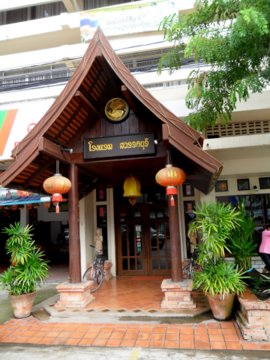
Sawankaburi Boutique Hotel Getting around Si Satchanalai There didn’t appear to be very much public transport in Sawan Khalok, everyone had their own cars or motor-bikes. There’s an inter-city bus service but none within the city. However, there’s this specially converted motorized trishaw operating within the city, the front cargo compartment has been fitted with seats for two and a motor-cycle fitted to the trishaw. 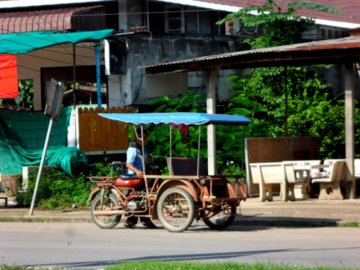
Motorized trishaw Table of contents Coming attractions in Sukhothai
Table of contents My thanks I am grateful to Lumpoo Pramchit for showing me the historical and cultural sites in her home province of Sukhothai. Table of contents Next month We visit the Ban Ko Noi ancient ceramics preservation site in Sri Satchanalai, Sukhothai. 

If you enjoyed reading this e-zine, please forward it to a friend. If you received this from a friend and found it interesting, please subscribe at Bangkok Travelbug. What you think of the Bangkok Travelbug? We love to hear from you What other subscribers have said Till next month then. Eric Lim Find us on Facebook Stay updated with what’s new at Tour Bangkok Legacies. Copy the link below and paste it into your Google Reader, NetNewsWire or your favourite feed reader. https://www.tour-bangkok-legacies.com/tour-Bangkok-legacies.xml If you use My Yahoo! or My MSN, head over to my home page and click on the button for your favourite Web-based feed reader. Visit our home page at Tour Bangkok Legacies. Copyright@2008-2013 Tour Bangkok Legacies All rights reserved |
| Back to Back Issues Page |